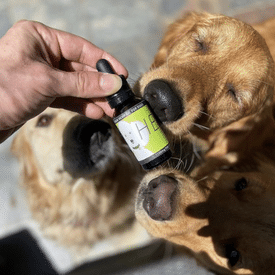Greg Gerdeman on Cannabinoid Treatment for Rheumatism. (2016, June 5).
Gamble L-J, Boesch JM, Frye CW, Schwark WS, Mann S, Wolfe L, Brown H, Berthelsen ES and Wakshlag JJ (2018) Pharmacokinetics, Safety, and Clinical Efficacy of Cannabidiol Treatment in Osteoarthritic Dogs. Front. Vet. Sci. 5:165. doi: 10.3389/fvets.2018.00165
Kukanich B, Bidgood T, Knesl O. Clinical pharmacology of nonsteroidal anti-inflammatory drugs in dogs. Vet Anaesth Analg. (2012) 39:69–90. doi: 10.1111/j.1467-2995.2011.00675.x
Lomas AL, Grauer GF. The renal effects of NSAIDs in dogs. J Am Anim Hosp Assoc. (2015) 51:197–203. doi: 10.5326/JAAHA-MS-6239
Monteiro-Steagall BP, Steagall PV, Lascelles BD. Systematic review of nonsteroidal anti-inflammatory drug-induced adverse effects in dogs. J Vet Intern Med. (2013) 27:1011–9. doi: 10.1111/jvim.12127
Luna SP, Basílio AC, Steagall PV, Machado LP, Moutinho FQ, Takahira RK, et al. Evaluation of adverse effects of long-term oral administration of carprofen, etodolac, flunixin meglumine, ketoprofen, and meloxicam in dogs. Am J Vet Res. (2007) 68:258–64. doi: 10.2460/ajvr.68.3.258
Di Marzo V, Bifulco M, De Petrocellis L. The endocannabinoid system and its therapeutic exploitation. Nat Rev Drug Discov. (2004) 3:771–84. doi: 10.1038/nrd1495
Ben-Shabat S, Hanuš LO, Katzavian G, Gallily R. New cannabidiol derivatives: synthesis, binding to cannabinoid receptor, and evaluation of their antiinflammatory activity. J Med Chem. (2006) 49:1113–7. doi: 10.1021/jm050709m
Maione S, Piscitelli F, Gatta L, Vita D, De Petrocellis L, Palazzo E, et al. Non-psychoactive cannabinoids modulate the descending pathway of antinociception in anaesthetized rats through several mechanisms of action. Br J Pharmacol. (2011) 162:584–96. doi: 10.1111/j.1476-5381.2010.01063.x
Herkenham M, Lynn AB, Little MD, Johnson MR, Melvin LS, de Costa BR, et al. Cannabinoid receptor localization in brain. Proc Natl Acad Sci USA. (1990) 875:1932–6. doi: 10.1073/pnas.87.5.1932
Galiègue S, Mary S, Marchand J, Dussossoy D, Carrière D, Carayon P, et al. Expression of central and peripheral cannabinoid receptors in human immune tissues and leukocyte subpopulations. Eur J Biochem. (1995) 232:54–61. doi: 10.1111/j.1432-1033.1995.tb20780.x
Cabral GA, Raborn ES, Griffin L, Dennis J, Marciano-Cabral F. CB2 receptors in the brain: role in central immune function. Br J Pharmacol. (2008) 153:240–51. doi: 10.1038/sj.bjp.0707584
Richardson D, Pearson RG, Kurian N, Latif ML, Garle MJ, Barrett DA, et al. Characterisation of the cannabinoid receptor system in synovial tissue and fluid in patients with osteoarthritis and rheumatoid arthritis. Arthritis Res Ther. (2008) 10:R43. doi: 10.1186/ar2401
Rapaka RS, Makriyannis, A, editors. NIDA Research Monograph 79 A RAUS Review Report. Struct-Activ Relationsh Cannabin (1987) 79:1–210.
Zhornitsky S, Potvin S. Cannabidiol in humans – the quest for therapeutic targets. Pharmaceuticals (2012) 5:529–52. doi: 10.3390/ph5050529
Sacerdote P, Martucci C, Vaccani A, Bariselli F, Panerai AE, Colombo A, et al. The nonpsychoactive component of marijuana cannabidiol modulates chemotaxis and IL-10 and IL-12 production of murine macrophages both in vivo and in vitro. J Neuroimmunol. (2005) 159:97–105. doi: 10.1016/j.jneuroim.2004.10.003
Costa B, Giagnoni G, Franke C, Trovato AE, Colleoni M. Vanilloid TRPV1 receptor mediates the antihyperalgesic effect of the nonpsychoactive cannabinoid, cannabidiol, in a rat model of acute inflammation. Br J Pharmacol. (2004)143:247–50. doi: 10.1038/sj.bjp.0705920
Comelli F, Giagnoni G, Bettoni I, Colleoni M, Costa B. Antihyperalgesic effect of a Cannabis sativa extract in a rat model of neuropathic pain: mechanisms involved. Phytother Res. (2008) 22:1017–24. doi: 10.1002/ptr.2401
Shiue SJ, Peng HY, Lin CR, Wang SW, Rau RH, Cheng JK. Continuous intrathecal infusion of cannabinoid receptor agonists attenuates nerve ligation–induced pain in rats. Reg Anesth Pain Med. (2017) 42:499–506. doi: 10.1097/AAP.0000000000000601
Cui JH, Kim WM, Lee HG, Kim YO, Kim CM, Yoon MH. Antinociceptive effect of intrathecal cannabinoid receptor agonist WIN 55,212-2 in a rat bone tumor pain model. Neurosci Lett. (2011) 493:67–71. doi: 10.1016/j.neulet.2010.12.052
Malfait AM, Gallily R, Sumariwalla PF, Malik AS, Andreakos E, Mechoulam R, et al. The nonpsychoactive cannabis constituent cannabidiol is an oral anti-arthritic therapeutic in murine collagen-induced arthritis. Proc Natl Acad Sci USA. (2000) 97:9561–6. doi: 10.1073/pnas.160105897
Zgair A, Wong JC, Sabri A, Fischer PM, Barrett DA, Constantinescu CS, et al. Development of a simple and sensitive HPLC–UV method for the simultaneous determination of cannabidiol and Δ(9)-tetrahydrocannabinol in rat plasma. J Pharm Biomed Anal. (2015) 114:145–51. doi: 10.1016/j.jpba.2015.05.019
Kirkwood JS, Broeckling CD, Donahue S, Prenni JE. A novel microflow LC-MS method for the quantitation of endocannabinoids in serum. J Chromatogr B Analyt Technol Biomed Life Sci. (2016) 1033–1034:271–7. doi: 10.1016/j.jchromb.2016.08.035
MacLean B, Tomazela DM, Shulman N, Chambers M, Finney GL, Frewen B, et al. Skyline: an open source document editor for creating and analyzing targeted proteomics experiments. Bioinformatics (2010) 26:966–8. doi: 10.1093/bioinformatics/btq054
Broccardo CJ, Schauer KL, Kohrt WM, Schwartz RS, Murphy JP, Prenni JE. Multiplexed analysis of steroid hormones in human serum using novel microflow tile technology and LC–MS/MS. J Chromatogr B Analyt Technol Biomed Life Sci. (2013) 934:16–21. doi: 10.1016/j.jchromb.2013.06.031
Shrivastava A, Gupta VB. Methods for the determination of limit of detection and limit of quantitation of the analytical methods. Chron Young Sci. (2011) 2:21–5. doi: 10.4103/2229-5186.79345
McCarthy G, O’Donovan J, Jones B, McAllister H, Seed M, Mooney C. Randomised double-blind, positive-controlled trial to assess the efficacy of glucosamine/chondroitin sulfate for the treatment of dogs with osteoarthritis. Vet J. (2007) 174:54–61. doi: 10.1016/j.tvjl.2006.02.015
Brown DC, Bell M, Rhodes L. Power of treatment success definitions when the Canine Brief Pain Inventory is used to evaluate carprofen treatment for the control of pain and inflammation in dogs with osteoarthritis. Am J Vet Res. (2013) 74:1467–73. doi: 10.2460/ajvr.74.12.1467
Brown DC, Boston RC, Coyne JC, Farrar JT. Ability of the canine brief pain inventory to detect response to treatment in dogs with osteoarthritis. J Am Vet Med Assoc. (2008) 233:1278–83. doi: 10.2460/javma.233.8.1278
Hudson JT, Slater MR, Taylor L, Scott HM, Kerwin SC. Assessing repeatability and validity of a visual analogue scale questionnaire for use in assessing pain and lameness in dogs. Am J Vet Res. (2004) 65:1634–43. doi: 10.2460/ajvr.2004.65.1634
Fahie MA, Ortolano GA, Guercio V, Schaffer JA, Johnston G, Au J. A randomized controlled trial of the efficacy of autologous platelet therapy for the treatment of osteoarthritis in dogs. J Am Vet Med Assoc. (2013) 243:1291–7. doi: 10.2460/javma.243.9.1291
Lubke, Gitta H, Muthen, Bengt O. Applying multigroup confirmatory factor models for continuous outcomes to likert scale data complicates meaningful group comparisons. Struct Equat Model. (2004) 11:514–34. doi: 10.1207/s15328007sem1104_2
Carifio J, Perla R. Ten common misunderstandings, misconceptions, persistent myths and urban legends about likert scales and likert response formats and their antidotes. J Soc Sci. (2007) 2:106–16.
Samara E, Bialer M, Mechoulam R. Pharmacokinetics of cannabidiol in dogs. Drug Metab Dispos. (1988) 16:469–72.
Garrett ER, Hunt CA. Physicochemical properties, solubility, and protein binding of delta9-tetrahydrocannabinol. J Pharm Sci. (1974) 63:1056–64. doi: 10.1002/jps.2600630705
Harvey DJ, Samara E, Mechoulam R. Comparative metabolism of cannabidiol in dog, rat and man. Pharmacol Biochem Behav. (1991) 40:523–32.
Conzemius mg, Evans RB. Caregiver placebo effect for dogs with lameness from osteoarthritis. J Am Vet Med Assoc. (2012) 241:1314–9. doi: 10.2460/javma.241.10.1314
Bornheim LM, Correia MA. Effect of cannabidiol on cytochrome P-450 isozymes. Biochem Pharmacol. (1989) 38:2789–94. doi: 10.1016/0006-2952(89)90432-2
Khanna P, Gupta MB, Gupta GP, Sanwal GG, Ali B. Influence of chronic oral intake of cannabis extract on oxidative and hydrolytic metabolism of xenobiotics in rat. Biochem Pharmacol. (1991) 41:109–13. doi: 10.1016/0006-2952(91)90017-Y
Yamamoto I, Watanabe K, Narimatsu S, Yoshimura H. Recent advances in the metabolism of cannabinoids. Int J Biochem Cell Biol. (1995) 27:741–6. doi: 10.1016/1357-2725(95)00043-O
Kogan LR, Hellyer PW, Robinson NG. Consumers’ perceptions of hemp products for animals. J Am Holist Vet Med Assoc. (2016) 42:40–8.
Campora L, Miragliotta V, Ricci E, Cristino L, Di Marzo V, Albanese F, et al. Cannabinoid receptor type 1 and 2 expression in the skin of healthy dogs and dogs with atopic dermatitis. Am J Vet Res. (2012) 73:988–95. doi: 10.2460/ajvr.73.7.988
Karler R, Turkanis SA. The cannabinoids as potential antiepileptics. J Clin Pharmacol. (1981) 21:437S−48S. doi: 10.1002/j.1552-4604.1981.tb02624.x
Kathmann M, Flau K, Redmer A, Trankle C, Schlicker E. Cannabidiol is an allosteric modulator at mu- and delta-opioid receptors. Naunyn Schmiedebergs Arch Pharmacol. (2006) 372:354–61. doi: 10.1007/s00210-006-0033-x
Cabral GA, Griffin-Thomas L. Emerging role of the cannabinoid receptor CB2 in immune regulation: therapeutic prospects for neuroinflammation. Expert Rev Mol Med. (2009) 11:e3. doi: 10.1017/S1462399409000957
(2019). Retrieved 19 September 2019, from https://www.sciencedaily.com/releases/2019/05/190521101450.htm
Stephanie McGrath, Lisa R. Bartner, Sangeeta Rao, Rebecca A. Packer, Daniel L. Gustafson. Randomized blinded controlled clinical trial to assess the effect of oral cannabidiol administration in addition to conventional antiepileptic treatment on seizure frequency in dogs with intractable idiopathic epilepsy. Journal of the American Veterinary Medical Association, 2019; 254 (11): 1301 DOI: 10.2460/javma.254.11.1301
Mogi, C., & Fukuyama, T. (2019). Cannaibiol as a Potential Anti-Epileptic Dietary Supplement in Dogs with Suspected Epilepsy. Retrieved 19 September 2019, from https://www.uco.es/ucopress/ojs/index.php/pet/article/view/11800/10795
Bradford, B. (2019). AKC Canine Health Foundation. Retrieved 19 September 2019, from http://www.akcchf.org/news-events/news/clinical-trial-to-study.html
Samara E, e. (1988). Pharmacokinetics of cannabidiol in dogs. – PubMed – NCBI. Retrieved 19 September 2019, from https://www.ncbi.nlm.nih.gov/pubmed/2900742
Soares, V., & Campos, A. (2019). Evidences for the Anti-panic Actions of Cannabidiol. Retrieved 19 September 2019, from https://www.ncbi.nlm.nih.gov/pmc/articles/PMC5412699/
Bitencourt, R., Pamplona, F., & Takahashi, R. (2019). A current overview of cannabinoids and glucocorticoids in facilitating extinction of aversive memories: Potential extinction enhancers. Retrieved 19 September 2019, from https://doi.org/10.1016/j.neuropharm.2012.05.039
Manzanares, J., Julian, M., & Carrascosa, A. (2019). Role of the Cannabinoid System in Pain Control and Therapeutic Im…: Ingenta Connect. Retrieved 19 September 2019, from https://www.ingentaconnect.com/content/ben/cn/2006/00000004/00000003/art00009
Pamplona, F., Rolim da Silva, L., & Can, A. (2019). Potential Clinical Benefits of CBD-Rich Cannabis Extracts Over Purified CBD in Treatment-Resistant Epilepsy: Observational Data Meta-analysis. Retrieved 19 September 2019, from https://www.frontiersin.org/articles/10.3389/fneur.2018.00759/full?utm_source=FRN&utm_medium=EMAIL_IRIS&utm_campaign=EMI_FRN_ARTICLEPUBLISHED_FOLLOWERS&utm_content=ARTICLE_TITLE
Scott, S., Lewis, N., Lee, H., & Hughes, S. (2019). Cannabidiol in Anxiety and Sleep: A Large Case Series. Retrieved 19 September 2019, from http://www.thepermanentejournal.org/issues/2019/winter/6960-cannabis.html
Chiocchetti, R., Galiazzo, G., Tagliavia, C., Stanzani, A., Giancola, F., Menchetti, M., … Mandrioli, L. (2019, September 19). Cellular Distribution of Canonical and Putative Cannabinoid Receptors in Canine Cervical Dorsal Root Ganglia. Retrieved October 19, 2019, from https://www.ncbi.nlm.nih.gov/pubmed/31608295/.
Hartsel, J. A., Boyar, K., Pham, A., Silver, R. J., & Makriyannis, A. (2019). Cannabis in Veterinary Medicine: Cannabinoid Therapies for Animals. Nutraceuticals in Veterinary Medicine, 121–155. doi: 10.1007/978-3-030-04624-8_10
Russo, E. B., & Mcpartland, J. M. (2002). Cannabis is more than simply Δ9-tetrahydrocannabinol. Psychopharmacology, 164(4), 431-432. DOI:10.1007/s00213-002-1348-z
Kathmann M, Flau K, Redmer A, Tränkle C, Schlicker E (February 2006). “Cannabidiol is an allosteric modulator at mu- and delta-opioid receptors”. Naunyn Schmiedebergs Arch. Pharmacol. 372 (5): 354–61.
Pertwee RG (2006). “The pharmacology of cannabinoid receptors and their ligands: an overview”. International Journal of Obesity, 30: S13-S18
Campos AC, Moreira FA, Gomes FV, Del Bel EA, Guimarães FS (December 2012). “Multiple mechanisms involved in the large-spectrum therapeutic potential of cannabidiol in psychiatric disorders”. Philosophical Transactions of the Royal Society of London. Series B, Biological Sciences (Review). 367(1607): 3364–78.
Takeda S1, Okajima S, Miyoshi H, Yoshida K, Okamoto Y, Okada T, Amamoto T, Watanabe K, Omiecinski CJ, Aramaki H. Cannabidiolic acid, a major cannabinoid in fiber-type cannabis, is an inhibitor of MDA-MB-231 breast cancer cell migration. Toxicol Lett. 2012 Nov 15;214(3):314-9
Berman, Paula et al. “A New ESI-LC/MS Approach for Comprehensive Metabolic Profiling of Phytocannabinoids in Cannabis.” Scientific Reports 8 (2018): 14280. PMC Web 19 September 2018
Booth, Judith K., Jonathan E. Page, and Jörg Bohlmann. “Terpene Synthases from Cannabis Sativa.” Ed. Björn Hamberger. PLoS ONE 12.3 (2017): e0173911. PMC. Web. 19 September 2019.
Andre, Christelle M.; Hausman, Jean-Francois; Guerriero, Gea, “Cannabis Sativa: The Plant of the Thousand and One Molecules”, Frontiers in Plant Science, 7 (2016):19, PMC Web. 19 September 2019
Gertsch, Jürg; Pertwee, Roger G; Di Marzo, Vincenzo (2010). Phytocannabinoids beyond the Cannabis plant – do they exist? British journal of Pharmacology, 160.3 (2010), 523-529. PMC.
Goldstein, B. (2016). Cannabis revealed: How the world’s most misunderstood plant is healing everything from chronic pain to epilepsy. Bonni S. Goldstein MD INC
Munro S, Thomas KL, Abu-Shaar M. (Sep 1993). “Molecular characterization of a peripheral receptor for cannabinoids”. Nature. 365 (6441): 61-5
Cabral GA, Griffin‐Thomas L (2009). Emerging role of the cannabinoid receptor CB2 in immune regulation: therapeutic prospects for neuroinflammation. Expert Rev Mol Med 11: e3.
Mark A. Twardowski et al, Effects of Cannabis Use on Sedation Requirements for Endoscopic Procedures, The Journal of the American Osteopathic Association (2019). DOI: 10.7556/jaoa.2019.052
Herkenham M, Lynn AB, Little MD, Cannabinoid receptor localization in brain. Proceedings of the National Academy of Sciences of the United States of America. 1990:87 (5): 1932-196
Sultan, A.S., Marie, M.A. & Sheweita S.A. (2018). Novel Mechanism of Cannabidiol-induced Apoptosis in Breast Cancer Cell Lines. Breast (Edinburgh, Scotland), 41, 34–41.
Zuardi AW, Cosme RA, Graeff FG, Guimarães FS. Effects of ipsapirone and cannabidiol on human experimental anxiety. J Psychopharmacol. 1993;7:82–88.
Naftali T, Bar-Lev Schleider L, Dotan I, Lansky EP, Sklerovsky Benjaminov F, Konikoff FM. Cannabis induces a clinical response in patients with Crohn’s disease: a prospective placebo-controlled study. Clin Gastroenterol Hepatol. 2013 Oct;11(10):1276-1280.e1. doi: 10.1016/j.cgh.2013.04.034.
Stephanie McGrath, DVM, MS, Lisa R. Bartner, DVM, MS, Sangeeta Rao, BVSc, MVSc, PhD, Lori R. Kogan, PhD, Peter W. Hellyer, DVM, MS. “A Report of Adverse Effects Associated With the Administration of Cannabidiol in Healthy Dogs”. AHVMA Journal, Volume 52 Fall 2018
Vaughn D, Kulpa J, Paulionis L. “Preliminary Investigation of the Safety of Escalating Cannabinoid Doses in Healthy Dogs” Front Vet Sci. 2020 Feb 11;7:51. doi: 10.3389/fvets.2020.00051. eCollection 2020.
Mark Barton Frank, Qing Yang, Jeanette Osban, Joseph T Azzarello, Marcia R Saban, Ricardo Saban, Richard A Ashley, Jan C Welter, Kar-Ming Fung, Hsueh-Kung Lin. “Frankincense oil derived from Boswellia carteri induces tumor cell specific cytotoxicity” 2009 Mar 18. doi: 10.1186/1472-6882-9-6.
Nicholas A.Jones, Sarah E.Glyn, SatoshiAkiyama, Thomas D.M.Hill, Andrew J.Hill, Samantha E.Weston, Matthew D.A.Burnett, YukiYamasaki, Gary J.Stephens, Benjamin J.Whalley, Claire M.Williams. “Cannabidiol exerts anti-convulsant effects in animal models of temporal lobe and partial seizures.” Volume 21, Issue 5, Just 2012, Pages 344-352
Lisa R. Bartner, Stephanie McGrath, Sangeeta Rao, Linda K. Hyatt, Luke A. Wittenburg. “Pharmacokinetics of cannabidiol administered by 3 delivery methods at 2 different dosages to healthy dogs.” 2018 Jul; 82(3): 178–183.
Eleftheria Lakiotaki, Constantinos Giaginis, Maria Tolia, Paraskevi Alexandrou, Ioanna Delladetsima, Ioanna Giannopoulou, George Kyrgias, Efstratios Patsouris, and Stamatios Theocharis. “Clinical Significance of Cannabinoid Receptors CB1 and CB2 Expression in Human Malignant and Benign Thyroid Lesions.” 2015 Oct 11.














